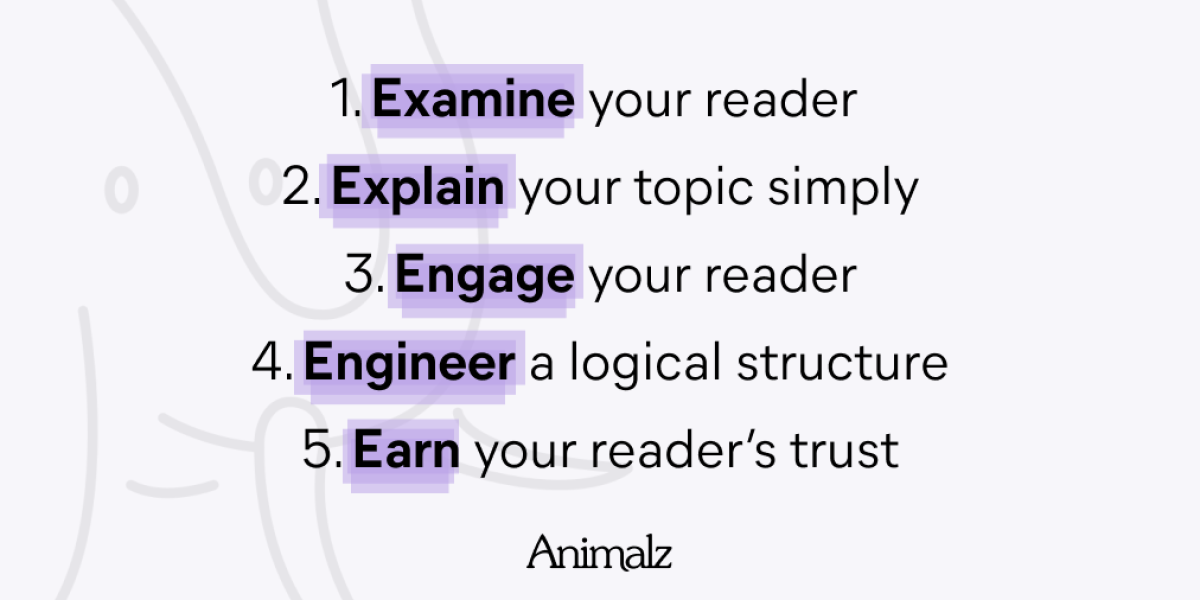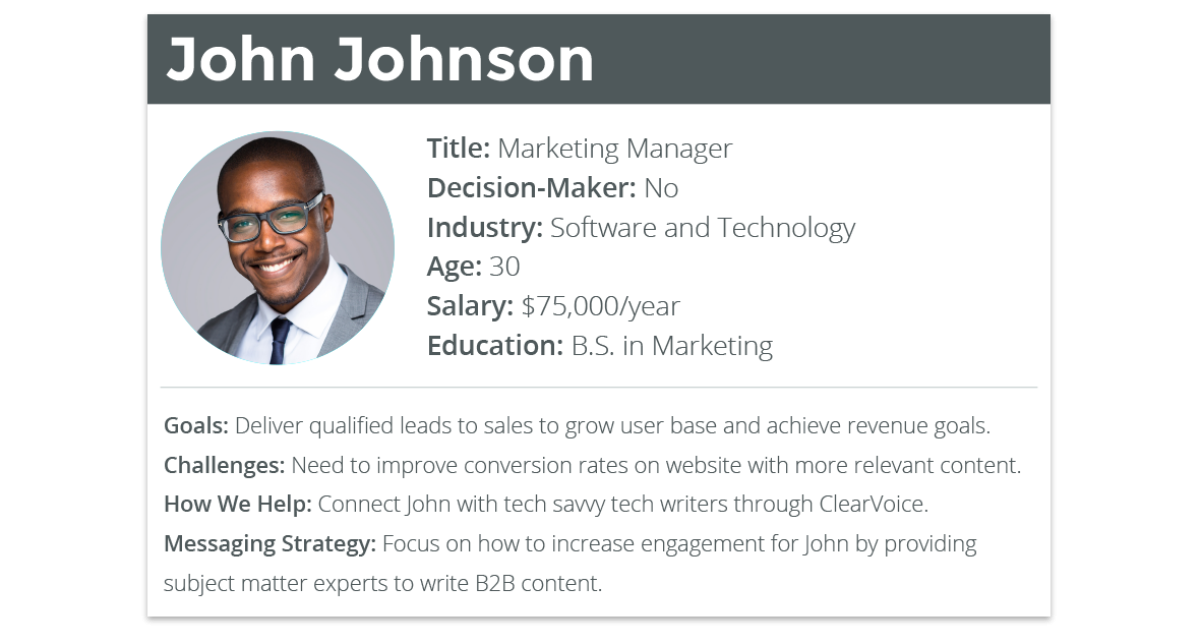Many content marketing agencies say they can define high-quality content. Some say it’s original and relevant. Others say it uses data and achieves marketing objectives. Few know how to do those things or they know but don’t want to tell anyone. We know and we want to share our method.Here’s the thing: Writing is mostly thinking, and thinking is hard. To write well, you have to do a lot of thinking about your reader and about your topic. The Animalz Method for writing high-quality content takes you through this process in five steps, all of which just happen to start with the letter E.
Examine your reader — Get to know them beyond their marketing persona, like you would a friend’s personality and nuances.
Explain your topic simply — Understand what you’re writing about well enough so that you can explain it to a young person.
Engage your reader — Use an angle, title, and hook they can’t ignore and the kind of writing they crave.
Engineer a logical structure — Guide your reader from the first sentence to the last, increasingly convincing them of your thesis.
Earn your reader’s trust — Write with authority from a place of knowledge, even when sharing the knowledge of an expert.
Use the Animalz method to write compelling, logical, and trustworthy text grounded in knowledge of the reader and the topic.

1. Examine Your Reader
If you don’t know your reader very well, you can’t choose a topic, an angle, or a style that will compel them to read what you write. Get to know your reader beyond their marketing persona, like you would a friend’s personality and nuances. Then think about everything from their perspective, framing each piece of content in a way that will be interesting to them.Start with who your reader is not: Your reader is not you, your manager, your customer, or even your editor. These folks may be giving you feedback and even approving your final draft, but they are not your reader.The person you’re writing for may be described to you, generally, as “an IT leader” or “an internal communications manager.” Sometimes your reader is very specific, like this: “an executive considering moving the company away from on-premise customer service and toward Contact Center as a Service (CCaaS) but confused about data sovereignty.”
Marketing Personas Are Good
Most often, you’ll be asked to write for a persona. These are generic, fictional descriptions of a target audience. Here’s an example of a B2B buyer persona from a post by Alexa:

If you’re asked to write for the “John Johnson” above, you know that he has a college degree, that he’s been in the workforce for under a decade, that he will not be the one to decide whether his company buys what your customer is selling (but he likely has their ear), and you have a sense of what he’s concerned about. A persona is a starting line. It’s not the finish line.
Meetings With Readers Are Better
Talk to as many of your readers as you can as regularly as you can. Yes, the real-life people. Ask if the company you’re writing for can put you in touch with some of their customers. Then dig around on LinkedIn and Twitter.Once you identified a few, reach out and ask if you can take 15 minutes of their time for an informational interview. Explain that you write content for marketing managers, for example, and that you want to get to know your readers better. You’ll be surprised at how willing most people are to talk about themselves.Start with these questions:
What’s a typical day look like for you? Get a feel for how they spend their time at work.
What’s your favorite part of your job as a marketing manager? Learn what they like about their role and the industry.
What do you wish was different about your role? Learn what tools they wish they had, what they wish they could do faster or delegate, what they wish they had more time for, etc.
What newsletters do you subscribe to? Subscribe to them when you get off the call. Note similarities across the publications.
What conferences have you attended? Look up past conference information when you get off the call. Watch recorded sessions if you can. Note who spoke.
What LinkedIn groups, subreddits, Facebook groups are you a part of? Join these groups to learn what’s important to your reader, what they don’t understand, what they wish they knew, and how they talk.
Who do you follow on Twitter? Make a Twitter list of these same people and companies, and check it often.
What was the last thing you googled for work? It could be your next article topic!
Sending them questions to answer or a survey to fill out via email isn’t as helpful as talking to them on the phone or Zoom. Do whatever you can to actually talk to your reader face to face. (It’s also good interview experience.)You’re doing this work for two reasons: 1) to learn what they care about so that you can choose topics (with Google’s help) they want to read about, and 2) to broaden your own understanding of those same topics and the industry. Plus, you may pick up some helpful terminology and insider vernacular — both of which will increase your credibility.OK. You know your readers or are getting to know them. It’s time to start thinking about the article you’re going to write just for them. Commence brain powers!
2. Explain Your Topic Simply
You’ve probably heard the adage that the best way to learn something new is to teach it. But teaching it to a peer is easier than teaching it to a child. And that’s how far we suggest writers go when learning about a new topic. Understand what you’re writing about well enough that you can explain it to a child.It’s called the Feynman Technique. If you can break down a concept into its simplest parts using common words, you understand it. Below is an excellent example of what’s sometimes called “explain like I’m five” (ELI5) from DEV Community. It’s where coders can go to stay up to date.

When one of our editors asks a writer to ELI5, it’s not because the reader is a five-year-old; it’s because they suspect the writer doesn’t fully understand what they’re writing about. Here are the tell-tale signs:
A jargon party — Sentences that read like they came from the Corporate B.S. Generator are either trying to make the writer sound smart or (maybe even and) hiding the fact that the writer doesn’t know what they’re writing about. Here’s one: Quickly simplify collaborative internal processes by regularly benchmarking results, seamlessly integrating the findings along the way by leveraging the expertise of — and getting buy-in from — management.
An idiom festival — The combination of words that make up idioms do not, by definition, mean anything. Use them sparingly and only if you’re certain that the reader is familiar with them. Otherwise, it seems like you’re trying to hide your own ignorance. What I’m trying to say is that if you beat around the bush because you’re caught between a rock and a hard place, your attempt at cutting corners will send the reader on a wild goose chase for meaning.
An SME jamboree — Quoting subject matter experts (SMEs) is one way to defend the arguments you’re making in a piece of content. However, quotations should be used as supporting material, not the material. If you’re using a lot of word-for-word content, consider conducting an interview and publishing that instead.
If you notice any of the above in your own writing, take heed. Make sure you’ve done the hard thinking necessary to explain your topic simply.
3. Engage Your Reader
Hook them with a title they have to click on, and maintain their attention throughout with your writing, your formatting choices, your images, and embedded videos — whatever you know the reader prefers. Think about everything from the reader’s perspective, and frame each piece in a way that will be interesting to them.
Find a Surprising Angle
Compelling content starts with a topic and, equally important, the angle you use to write about that topic. Choose a counterintuitive angle, and you’ve hit the jackpot. Knowing what topic to write about and how to write about it counterintuitively requires two things:
You know what’s important to your reader.
You know enough about it to be able to turn it on its head.
If you can’t reference your own reports, studies, interviews, surveys, or blog posts, find — and cite! — someone else’s. (But make sure they are trustworthy.) Through research, you learn about the topic and gather internal and external links, which will make your content more compelling…to search engines, too.Need an example? Check out “How to Grow a Blog the Hard Way” on our blog or this one published by the company behind a free mobile app that young people can use to apply for scholarships.
Considering the reader — the nonprofit education community — the title is a shocker. But it doesn’t stop there.
Make Every Word Count
When it comes time to put words on the page, be creative — writing is, after all, a craft — but keep your reader front and center.
Write a title that makes your reader want to click it — This will require you to draft many (at least 10) article titles. If you’re new to content marketing, use a tool like CoSchedule’s Headline analyzer Chrome extension to test your headlines…with the understanding that the tool will encourage you to copy the forms of existing successful headlines rather than try something new.
Write an intro that hooks your reader — You know them. What will get their attention? Why are they interested in what you’re writing about? Dig into that. Here’s the first paragraph of the Hello World article shown above:

Whoa. But tests are the foundation of our education system and how we determine, to a great extent, who will get into which colleges and receive which scholarships. The reader can’t not keep reading.
Write headers that make the article easy to scan — Few people read articles from top to bottom. Most skim and stop only when they read something interesting or helpful. Use your headings to compel them to stop skimming and start reading.
Write a conclusion that offers something extra — Don’t stop with a summary. If the reader makes it all the way to the end, give them just one more thing. Answer “What next?” Link to a downloadable checklist. Pique their curiosity about a related topic.
Break up the text with images, lists, and charts — Avoid the dreaded wall of text and make white space your friend. Stock images are better than nothing, sometimes. Rarely, but sometimes.
Keep paragraphs concise — Readers must work very hard to connect the ideas in articles written with one-sentence paragraphs; long paragraphs may make their eyes glaze over. Avoid overusing jargon and relying on repetition to meet a word count.
Weave a thread from top to bottom — Expert writers are excellent at starting an article with a simile or metaphor, an example, a tone of voice, a joke, a story, and then subtly using it throughout the entire article. Here’s an example.
Be inclusive — Use gender-neutral pronouns and examples, quotes, and images that represent multiple perspectives.
Need another example? Take a look at this article for research platform UserLeap called “Stop Using User Research to Confirm Your Hypotheses.”
Now, even if you nailed the angle and checked all the research boxes and wrote like Jia Tolentino, your article still may not be engaging.You must publish it when demand for it is high and on the distribution channel where your readers are most likely to discover it. Both require that you know what’s happening in your readers’ world and how they will find what you’ve written.We never said writing good content is easy.
4. Engineer a Logical Structure
Guide your reader from the first sentence to the last, increasingly convincing them of your thesis. This takes more than strong headings.Don’t overlap your ideas so that they bleed into each other. Don’t leave out anything essential. Don’t repeat yourself unnecessarily. Follow the mutually exclusive, collectively exhaustive (MECE) principle, even when writing listicles (yes, they, too, can be disorganized!).
Content marketers are usually learning about new topics — even new industries — every week. So how can you ensure that your articles are MECE? Follow Blake Thorne’s advice on How Marketers Can Develop Subject Matter Expertise Quickly.Next, decide the best way to present what you’re writing. This is your structure. Maybe the problems your reader is solving would benefit from skimmable listicles. Maybe they’re craving more analytical content via thought leadership. A how-to may be perfect for one reader (and one topic) and too basic for another. You should know.
5. Earn Your Reader’s Trust
Write with authority from a place of knowledge, even when sharing the knowledge of an expert.Claims without support are conjecture or, worse, your personal opinion. Unless you are a recognized expert in the field, you must back up your statements with facts to create trustworthy content. The more we can prove we know what we’re writing about, the more trustworthy we become.We use the customer’s proprietary data when possible and research quality sources when not. This article for multichannel ecommerce platform Sellbrite was built on the customer’s analysis of 1,160 ecommerce sellers and is an example of the former. For the latter, dig deep for examples, data, and expert opinions to make your content into more than just a random marketer’s two-cents.Here are three ways to do this:
Delve into the science behind your topic to reveal the complexity behind something people think is simple.
Use math to build credibility. One lighthearted example is an I Done This article about Jeff Bezos’ two-pizza team rule. Another, from digital adoption platform Whatfix, relies heavily on statistics: “Learn by Doing: A Data-Driven Argument for Enterprises.”
Stretch your reader’s imagination with new examples of something familiar. Check out this article titled “Planes, Skulls & Suitcases: Solving the Perfect Crime Through 3D Printing” from 3D printing technology developer and manufacturer Formlabs. Think you know what’s possible through 3D printing? Think again.

One surefire way to lose the reader’s trust? Write an article that obviously promotes the customer’s product or service. Focus on communicating valuable information rather than selling something. That is unless you’re writing for readers who want or need to know more about a product (aka BoFu content).What does trustworthiness look like on the page? Graphs of raw data, diagrams visually representing information, pull quotes from experts cited and linked to, screenshots of steps in a process. It means that directions in how-to posts are detailed and specific — less “should,” more “how” — so that readers can really do what you’re describing after reading your article. It means real-world examples like case studies and interviews — fewer hypotheticals — to ground your argument in reality.Once you’ve created compelling, logical, trustworthy content, you’ve done it, as in It. You’ve created high-quality content.
Writing High-Quality Content Is Hard
If this were easy, more people would be doing it, and the internet would not be so full of keyword-stuffed, copycat, meaningless content. Because writing is mostly thinking, we rely on two stages of outlining before starting a draft. Try it out. But first, get to know your reader.
